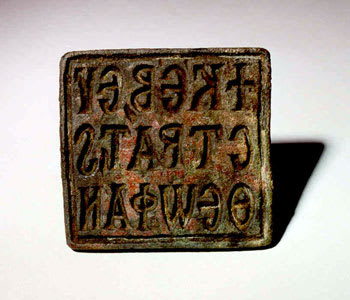Byzantine Bronze Square-Shaped Bread Stamp, 6th Century CE
Bronze
7 x 7.3 cm
2 3/4 x 2 7/8 in
2 3/4 x 2 7/8 in
X.0089
During the Roman era, bakeries were required to stamp their bread with an individual seal in order to trace the source of the loaves and to prevent fraud or theft...
During the Roman era, bakeries were required to stamp their bread with an individual seal in order to trace the source of the loaves and to prevent fraud or theft of imperial supplies. Upon the birth of the Byzantine Empire, bread stamps were still used, although their purpose had significantly changed. Although varying greatly in size and shape, the common characteristic of Byzantine bread stamps was the emphasis in drawing fracture lines that indicated to the priest where to cut the loaf. These lines become even more important on Eucharistic stamps that marked the consecrated bread for communion.
However, this square-shaped stamp was more likely used to prepare bread given to the faithful on specific religious events and holidays. The engraved inscription reads, “K(YPI)E B(OETHEI) EYSTPA T(IO) (KAI) THEOPHAN(EI),” and can be translated as, “God help Eustratios and Theophanes.” Square-shaped bread stamps are more rare than their circular counterparts because the loaves themselves were round. A square shape pressed into a round loaf tends to distort the roundness of the loaf. Square loaves were not feasible, since the corners would brown and harden before the rest of the loaf, not to mention the difficulty in keeping the loaf square once the yeast begins taking effect. Thus, this stamp would have once been pressed into a round loaf. As the loaf baked in the oven, the stamped image would grow larger as the loaf expanded. After the bread was finished baking and cooled, the loaf would be cut into pieces, leaving the stamped piece intact. If used during the Eucharist, this piece would have then served as the body of Christ. If used on another religious occasion, this piece would have been offered as a warm prayer in the names of two men, Eustratios and Theophanes.
However, this square-shaped stamp was more likely used to prepare bread given to the faithful on specific religious events and holidays. The engraved inscription reads, “K(YPI)E B(OETHEI) EYSTPA T(IO) (KAI) THEOPHAN(EI),” and can be translated as, “God help Eustratios and Theophanes.” Square-shaped bread stamps are more rare than their circular counterparts because the loaves themselves were round. A square shape pressed into a round loaf tends to distort the roundness of the loaf. Square loaves were not feasible, since the corners would brown and harden before the rest of the loaf, not to mention the difficulty in keeping the loaf square once the yeast begins taking effect. Thus, this stamp would have once been pressed into a round loaf. As the loaf baked in the oven, the stamped image would grow larger as the loaf expanded. After the bread was finished baking and cooled, the loaf would be cut into pieces, leaving the stamped piece intact. If used during the Eucharist, this piece would have then served as the body of Christ. If used on another religious occasion, this piece would have been offered as a warm prayer in the names of two men, Eustratios and Theophanes.
